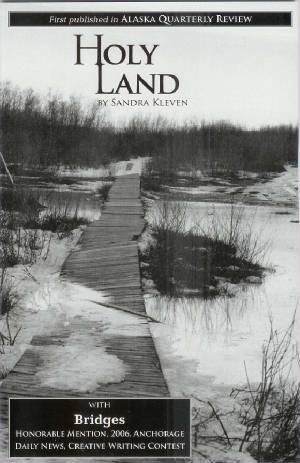Writing
Holy Land
A Note to the people of
Bethel and the Delta
Published in The Delta Discovery, 2007
by Sandy Kleven
If
you pick up the new issue of Alaska Quarterly Review, and go to page 221, you
will find these words, “I will take you to a place I used to be. I will take
you for no reason. I can tell you nothing. I have no story. I don’t even
want to go there myself.”
This
grim invitation opens a dramatic monolog called “Holy Land.” I wrote
it. It’s about Bethel. I want
to tell you how I came to write it and
why I waited eight years to publish it.
Bethel
has shaped my life in both profound and mundane ways. Last time I moved away someone
said, “Once a
river rat, always a river rat.” I’ve
started to tell people that I never really leave. Bethel has left a mark on me.
The
drama continues, “So...how do we begin this story you refuse to hear? Should
we start this tale of winter here, on this broad reach of river gone to ice”“
I
type from memory. I open the text to
check it, not fully confident.
When
I left Bethel the first time, in 1987, stories were stirring, drums were
drumming and my dreams kept waking me. I did not think I would ever go back to
Bethel. When, in “Holy Land” I write, “This is our store. I see it in dreams,”
I really mean it. I was living in Washington State and my dreams were haunted
by the Alaska Commercial Company.
“Holy
Land” finally began to “speak” to me in 1996. Once I began to
write, the voice changed. It wasn’t me, anymore. It
was someone talking to me. The voice was confronting me and all of us “Gussaqs”
who come to Bethel from Outside “bringing your brains in a briefcase with
school papers for your wall to show us that someone thinks you’re smart.”
The
voice was mad and frustrated. He was sad
and disappointed. He had a wry sense of
humor. He was forgiving and loving. I
liked him. I don’t think he’s a real person, or the ghost
of someone real, but he could be. He
should have a name. I’d like to know
what to call him. He is a Yup”ik man
about 45 years old, weary with life. By
the story’s end he seems powerful, somehow transformed by experience. He
says, “Wherever you go you will hear me
calling. My spirit hand will lace through your entrails. I will squeeze and
whisper “Do you remember me now?”
He
says “I will reach for those places touched by my stories when you stood
shivering in dark rooms your heart as pliant as grass. I will reclaim the part
of you that belong now to us.”
He
is describing what happens to many who come to Bethel from elsewhere. We are shaped
by the experience. In a best-case scenario, we are made better
people. This is what I was trying to capture in “Holy Land;” the way the region
can transform the transplants.
When
it was finished in 1997, I didn’t have the nerve to send it off. I questioned
myself. How
could I pretend to speak for a Yup”ik Eskimo man? I had to bring the piece
before Bethel’s native
people.
I
moved back to Bethel in 1998. I begin to
read in to people individually or in small groups. Their response helped me feel
confident that
the piece was authentic. In the spring
of 2004, at Just Desserts, a Bethel talent show, I read a large part of it for
an audience of several hundred people. The
audience appeared to fully embrace the piece. One person said, “It’s
about time somebody
said all that.”
Only
then, eight years after Holy Land surfaced in my mind, could I submit it. Alaska
Quarterly Review accepted it right away. The editor Ron Spatz said that the
piece had generated excitement. It was
published in June of 2005.
“Holy
Land” is a stark piece of writing. It is unflinching, as it faces hard facts,
but
the best part of “Holy Land” is the challenge leveled toward the pilgrims drawn
to the Holy Land. It asks for sacrifice.
You are welcome, all right. More than
that, you will never get away. And
all that is asked of you is everything.
Since then, I published “Holy Land” as a book, in small
runs of 100 copies. Four hundred copies
have sold, through my limited efforts, largely in Bethel. So far, I have been
the only one to bring up
the question of writing in Alaska native persona. I think this is because the
writing is drawn
from what I have heard said by the people of Bethel. It is a writing of witness,
in that way. Still, the issue is a very serious one.
Had I failed to properly record what I heard,
if I had been off target, it would have violated the integrity of the
people. That is why it had to be heard
by the people I was depicting, to give me the assurance that, in their opinion,
it was proper. One response, years
later, showed me a different impact of the piece. A woman in a Yukon village
wiped away tears,
and said, “I didn’t think a white person could know how we felt.”
I have written other pieces in persona because I
hear native voices speaking. I like the
way these voices use English, cutting to the bone of meaning, while restrained
emotion makes what is said shimmer with significance. I restrain myself
because when I put these
words on paper, I am on holy ground. My
feet have to be bare and clean hands must delicately engage this sacred
task.


